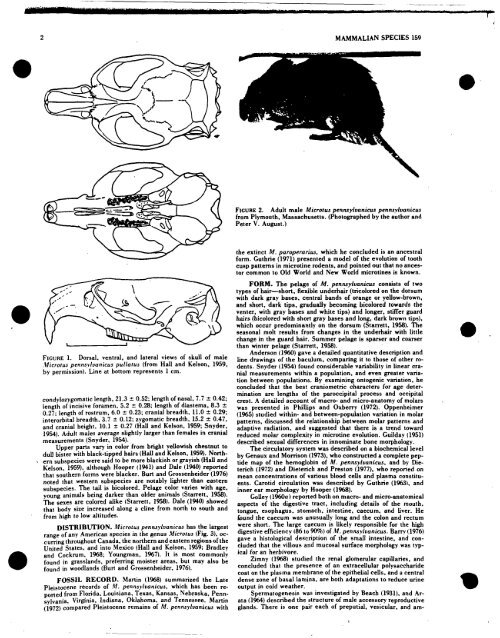Create successful ePaper yourself
Turn your PDF publications into a flip-book with our unique Google optimized e-Paper software.
2 MAMMALIAN SPECIES 159<br />
FIGURE 1. Dorsal, ventral, and lateral views <strong>of</strong> skull <strong>of</strong> male<br />
.Microrus penns.vlvanicus pullatus (from Hall and Kelson. 1959,<br />
by permission). Line at bottom represents 1 cm.<br />
condylozygomatic length, 21.3 ? 0.52: length <strong>of</strong> nasal. 7.7 + 0.42;<br />
length <strong>of</strong> incisive foramen. 5.2 2 0.28: length <strong>of</strong> diastema, 8.3 +<br />
0.27: length <strong>of</strong> rostrum, 6.0 2 0.23; cranial breadth, 11.0 + 0.29;<br />
interorbital breadth. 3.7 2 0.12: zvgomatic breadth. 15.2 z 0.47.<br />
and cranial height. 10.1 2 0.2i (Hall and Kelson, 1959; Snyder.<br />
1954). Adult males average slightlv larger than females in cranial<br />
measurements (Snyder, 1954).<br />
Upper parts vary in color from bright yellowish chestnut to<br />
dull bister with black-tipped hairs (Hall and Kelson, 1959). North-<br />
ern subspecies were said to be more blackish or grayish (Hall and<br />
Kelson. 1959). although Hooper (1941) and Dale (1940) reported<br />
that southern forms were blacker. Burt and Grossenheider (1976)<br />
noted that western subspecies are notably lighter than eastem<br />
subspecies. The tail is bicolored. Pelage color varies with age.<br />
young animals being darker than older animals (Starrett. 1958).<br />
The sexes are colored alike (Starrett. 1958). Dale (1940) showed<br />
that body size increased along a cline from north to south and<br />
from high to low altitudes.<br />
DISTRIBUTION. Microtus pennsylvanicus has the largest<br />
range <strong>of</strong> any American species in the genus .Microtus (Fig. 3). occurring<br />
throughout Canada, the northern and eastern regions <strong>of</strong> the<br />
United States, and into Mexico (Hall and Kelson, 1959; Bradley<br />
and Cockmm, 1%8; Youngman. 1967). It is most commonly<br />
found in grasslands, prefemng moister areas, but may also be<br />
found in t~oodlands (Burt and Grossenheider. 1976).<br />
FIGURE 2. Adult male Microtus pennsylvanicus pennsvlvanicus<br />
from Plymouth, Massachusetts. (Photographed by the author and<br />
Peter V. August.)<br />
the extinct rM. paroperariw. which he concluded is an ancestral<br />
form. Guthrie (1971) presented a model <strong>of</strong> the evolution <strong>of</strong> tooth<br />
cusp patterns in microtine rodents. and pointed out that no ances-<br />
tor common to Old World and New World microtines is known.<br />
FORM. The pelage <strong>of</strong> M. pennsylvanicus consists <strong>of</strong> two<br />
types <strong>of</strong> hair-short. flexible underhair (tricolored on the dorsum<br />
with dark gray bases. central bands <strong>of</strong> orange or yellow-brown,<br />
and short, dark tips. gradually becoming bicolored towards the<br />
venter, with gray bases and white tips) and longer. stiffer guard<br />
hairs (bicolored with short gray bases and long, dark brown tips),<br />
which occur predominantly on the dorsum (Starrett, 1958). The<br />
seasonal molt results from changes in the underhair with little<br />
change in the yard hair. Summer pelage is sparser and coarser<br />
than winter pelage (Starrett, 1958).<br />
Anderson (1%0) gave a detailed quantitative description and<br />
line drawings <strong>of</strong> the baculum, comparing it to those <strong>of</strong> other ro-<br />
dents. Snyder (1954) found considerable variability in linear cra-<br />
nial measurements within a population, and even greater varia-<br />
tion between populations. By examining ontogenic variation, he<br />
concluded that the best craniometric characters for aee deter-<br />
mination are lengths <strong>of</strong> the paroccipital process and-occipital<br />
crest. A detailed account <strong>of</strong> macro- and micro-anatomy <strong>of</strong> molars<br />
was presented in Phillips and Oxberry (1972). Oppenheimer<br />
(1%5) studied within- and between-population variation in molar<br />
patterns, discussed the relationship between molar patterns and<br />
adaptive radiation. and suggested that there is a trend toward<br />
reduced molar complexity in microtine evolution. Cuilday (1951)<br />
described sexual differences in innominate bone morphology.<br />
The circulatory system was described on a biochemical level<br />
by Genaux and Momson (1973). who constructed a complete pep-<br />
tide map <strong>of</strong> the hemoglobin <strong>of</strong> hf. pennsylvanicus, and by Die-<br />
terich (1972) and Dieterich and Preston (1977). who reported on<br />
mean concentrations <strong>of</strong> various blood cells and plasma constitu-<br />
ents. Carotid circulation was described by Guthrie (1%3). and<br />
inner ear morphology by Hooper (1%8).<br />
Golley (1%0a) reported both on macro- and micro-anatomical<br />
aspects <strong>of</strong> the digestive tract, including details <strong>of</strong> the mouth.<br />
tongue. esophagus, stomach, intestine, caecum, and liver. He<br />
found the caecum was unusually long and the colon and rectum<br />
were short. The large caecum is likely responsible for the high<br />
digestive efficiency (86 to W t) <strong>of</strong> iM. penmylvanicus. Barrv (1976)<br />
gave a histological description <strong>of</strong> the small intestine. and con-<br />
cluded that the villous and mucosal surface morphology was typ-<br />
ical for an herbivore.<br />
Zimny (1968) studied the renal glomemlar capillaries. and<br />
concluded that the presence <strong>of</strong> an extracellular polysaccharide<br />
coat on the olasma membrane <strong>of</strong> the epithelial cells. and a central<br />
FOSSIL RECORD. Martin (1968) summarized the Late dense zone<strong>of</strong> basal lamina, are both adaptations to reduce urine<br />
Pleistocene records <strong>of</strong> 4I. penns.vlvanicus, which has been re- output in cold weather.<br />
ported from Florida, Louisiana, Texas. Kansas. Nebraska, Penn- Spermatogenesis was investigated by Beach (1931). and .4r-<br />
sy]vania, Virginia, Indiana, Oklahoma, and Tennessee. Martin ata (1%4) described the stmcture <strong>of</strong> male accessory reproductive<br />
(1972) compared Pleistocene remains <strong>of</strong> M. pennsylvanicw with glands. There is one pair each <strong>of</strong> preputial, vesicular, and am-















